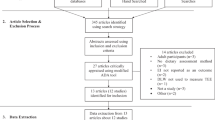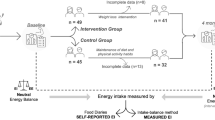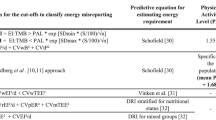Abstract
Objective: To compare self-reported total energy intake (TEI) estimated using two databases with total energy expenditure (TEE) measured by doubly labeled water in physically active lean and sedentary obese young women, and to compare reporting accuracy between the two subject groups.
Design: A cross-sectional study in which dietary intakes of women trained in diet-recording procedures were analyzed using the Minnesota Nutrition Data System (NDS; versions 2.4/6A/21, 2.6/6A/23 and 2.6/8.A/23) and Nutritionist III (N3; version 7.0) software. Reporting accuracy was determined by comparison of average TEI assessed by an 8 day estimated diet record with average TEE for the same period.
Results: Reported TEI differed from TEE for both groups irrespective of nutrient database (P<0.01). Measured TEE was 11.10±2.54 and 11.96±1.21 MJ for lean and obese subjects, respectively. Reported TEI, using either database, did not differ between groups. For lean women, TEI calculated by NDS was 7.66±1.73 MJ and by N3 was 8.44±1.59 MJ. Corresponding TEI for obese women were 7.46±2.17 MJ from NDS and 7.34±2.27 MJ from N3. Lean women under-reported by 23% (N3) and 30% (NDS), and obese women under-reported by 39% (N3) and 38% (NDS). Regardless of database, lean women reported higher carbohydrate intakes, and obese women reported higher total fat and individual fatty acid intakes. Higher energy intakes from mono- and polyunsaturated fatty acids were estimated by NDS than by N3 in both groups of women (P≤0.05).
Conclusions: Both physically active lean and sedentary obese women under-reported TEI regardless of database, although the magnitude of under-reporting may be influenced by the database for the lean women.
Sponsorship: USDA Hatch Project award (ARZT-136528-H-23-111) to LB Houtkooper and WH Howell.
European Journal of Clinical Nutrition (2001) 55, 940–950
This is a preview of subscription content, access via your institution
Access options
Subscribe to this journal
Receive 12 print issues and online access
$259.00 per year
only $21.58 per issue
Buy this article
- Purchase on Springer Link
- Instant access to full article PDF
Prices may be subject to local taxes which are calculated during checkout
Similar content being viewed by others
References
American College of Sports Medicine (1995) ACSM's Guidelines for Exercise Testing and Prescription, 5th edn. Baltimore, MD: Williams & Wilkins.
Bandini LG, Schoeller DA, Edwards J, Young VR, Oh SH & Dietz WH (1989) Energy expenditure during carbohydrate overfeeding in obese and nonobese adolescents Am. J. Physiol. 256 E357–E367
Black AE, Prentice AM, Goldberg GR, Jebb SA, Bingham SA, Livingstone MBE & Coward WA (1993) Measurements of total energy expenditure provide insights into the validity of dietary measurements of energy intake J. Am. Diet. Assoc. 93 572–579
Bland JM & Altman DG (1986) Statistical methods for assessing agreement between two methods of clinical measurement Lancet i 307–310
Buhl KM, Gallagher D, Hoy K, Matthews DE & Heymsfield SB (1995) Unexplained disturbance in body weight regulation: diagnostic outcome assessed by doubly labeled water and body composition analyses in obese patients reporting low energy intakes J. Am. Diet. Assoc. 95 1393–1400
DeLany JP, Schoeller DA, Hoyt RW, Askew EW & Sharp MA (1989) Field use of D2 18O to measure energy expenditure of soldiers at different energy intakes J. Appl. Physiol. 67 1922–1929
Dwyer JT (1988) Assessment of dietary intake In Modern Nutrition in Health and Disease, 7th edn, eds. ME Shils & VR Young 887–905 Philadelphia, PA: Lea & Febiger
Edwards JE, Lindeman AK, Mikesky AE & Stager JM (1993) Energy balance in highly trained endurance runners Med. Sci. Sports Exerc. Sci. 25 1398–1404
Elia M & Livesey G (1992) Energy expenditure and fuel selection in biological systems: the theory and practice of calculations based on indirect calorimetry and tracer methods World Rev. Nutr. Diet. 70 68–131
Going SB, Massett MP, Hall MC, Bare LA, Root PA, Williams DP & Lohman TG (1993) Detection of small changes in body composition by dual-energy X-ray absorptiometry Am. J. Clin. Nutr. 57 845–850
Kretsch MJ, Fong AKH & Green MW (1999) Behavioral and body size correlates of energy intake underreporting by obese and normal-weight women J. Am. Diet. Assoc. 99 300–306
Kushner RF, Schoeller DA, Fjeld CR & Danford L (1992) Is the impedance index (ht2/R) significant in predicting total body water? Am. J. Clin. Nutr. 56 835–839
Lee RD, Nieman DC & Rainwater M (1995) Comparison of eight microcomputer dietary analysis programs with the USDA Nutrient Data Base for Standard Reference J. Am. Diet. Assoc. 95 858–867
Lichtman SW, Pisarska K, Berman ER, Pestone M, Dowling H, Offenbacher E, Weisel H, Heshka S, Matthews DE & Heymsfield SB (1992) Discrepancy between self-reported and actual caloric intake and exercise in obese subjects New Engl. J. Med. 327 1893–1898
Lifson N, Gordon GB & McClintock R (1955) Measurement of total carbon dioxide production by means of D2 18O J. Appl. Physiol. 7 704–710
Lohman TG (1992) Advances in Body Composition Assessment Current Issues in Exercise Science Monograph no. 3 p2 2 Champaign, IL: Human Kinetics Publishers
Mertz W, Tsui JC, Judd JT, Reiser S, Hallfrisch J, Morris ER, Steele PD & Lashley E (1991) What are people really eating? The relation between energy intake derived from estimated diet records and intake determined to maintain body weight Am. J. Clin. Nutr. 54 291–295
Nieman DC, Butterworth DE, Nieman CN, Lee KE & Lee RD (1992) Comparison of six microcomputer dietary analysis systems with the USDA Nutrient Data Base for Standard Reference J. Am. Diet. Assoc. 92 48–56
N-Squared Computing (1991) Nutritionist III. Salem, OR: N-Squared Computing
Nutrition Coordinating Center, University of Minnesota (1992, 1994) The Minnesota Nutrition Data System Minneapolis, MN: The Nutrition Coordinating Center, Division of Epidemiology, School of Public Health, University of Minnesota
Paul AA & Southgate DAT (1978) McCance and Widdowson's The Composition of Food, 4th edn London: HMSO
Platte P, Pirke KM, Wade SE, Trimborn P & Fichter MM (1995) Physical activity, total energy expenditure, and food intake in grossly obese and normal weight women Int. J. Eat. Disord. 17 51–57
Prentice AM, Black AE, Coward WA, Davies HL, Goldberg GR, Murgatroyd PR, Ashford J, Sawyer M & Whitehead RG (1986) High levels of energy expenditure in obese women Br. Med. J. 292 983–987
Racette SB, Schoeller DA, Luke AH, Shay K, Hnilicka J & Kushner RF (1994) Relative dilution spaces of 2H- and 18O-labeled water in humans Am. J. Physiol. 267 E585–E590
Ravussin E, Harper IT, Rising R & Bogardus C (1991) Energy expenditure by doubly labeled water: validation in lean and obese subjects Am. J. Physiol. 261 (3 Pt 1) E402–E409
Riumallo JA, Schoeller D, Barrera G, Gattas V & Uauy R (1989) Energy expenditure in underweight free-living adults: impact of energy supplementation as determined by doubly labeled water and indirect calorimetry Am. J. Clin. Nutr. 49 239–246
Schoeller DA (1983) Energy expenditure from doubly labeled water: some fundamental considerations in humans Am. J. Clin. Nutr. 38 999–1005
Schoeller DA (1988) Measurement of energy expenditure in free-living humans by using doubly labeled water J. Nutr. 118 1278–1289
Schoeller DA (1995) Limitations in the assessment of dietary energy intake by self-report Metab. Clin. Exp. 44(2 Suppl 2) 18–22
Schulz LO, Alger S, Harper I, Wilmore JH & Ravussin E (1992) Energy expenditure of elite female runners measured by respiratory chamber and doubly labeled water J. Appl. Physiol. 72 23–28
Souci SW, Fachmann W & Kraut H (1986) Food Composition and Nutrition Tables 1986/87 Stuttgart: Wissenschaftlichhe Verlagsgesellscaft
Tan SP, Wenlock RW & Buss DH (1985) Immigrant Foods, Second Supplement to McCance and Widdowson's The Composition of Food London: HMSO
Weber JL, Tinsley AM, Houtkooper LB & Lohman TG (1997) Multimethod training increases portion-size estimation accuracy J. Am. Diet. Assoc. 97 176–179
Weir JB de V (1949) New methods for calculating metabolic rate with special reference to protein metabolism J. Physiol. 109 1–9
Wiles SJ, Nettleton PA, Black AE & Paul AA (1980) The nutrient composition of some cooked dishes eaten in Britain: a supplementary food composition table J. Hum. Nutr. 34 189–223
Acknowledgements
The authors are grateful to the young women who enthusiastically participated in this study. We thank Tausha Roberts and Tara Newton for their careful entry of diet records into the computer databases.
Author information
Authors and Affiliations
Corresponding author
Rights and permissions
About this article
Cite this article
Weber, J., Reid, P., Greaves, K. et al. Validity of self-reported energy intake in lean and obese young women, using two nutrient databases, compared with total energy expenditure assessed by doubly labeled water. Eur J Clin Nutr 55, 940–950 (2001). https://doi.org/10.1038/sj.ejcn.1601249
Received:
Revised:
Accepted:
Published:
Issue Date:
DOI: https://doi.org/10.1038/sj.ejcn.1601249
Keywords
This article is cited by
-
Examining differences between overweight women and men in 12-month weight loss study comparing healthy low-carbohydrate vs. low-fat diets
International Journal of Obesity (2021)
-
Comparisons of Energy Intake and Energy Expenditure in Overweight and Obese Women With and Without Binge Eating Disorder
Obesity (2012)
-
Assessment of dietary exposure related to dietary GI and fibre intake in a nutritional metabolomic study of human urine
Genes & Nutrition (2012)
-
Detection of Food Intake from Swallowing Sequences by Supervised and Unsupervised Methods
Annals of Biomedical Engineering (2010)
-
Measurement of dietary exposure: a challenging problem which may be overcome thanks to metabolomics?
Genes & Nutrition (2009)



